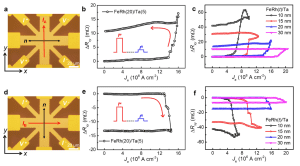
Owing to the extremely large exchange energy barriers, it has been a fundamental challenge to switch the Neel order of AFM systems using energy-efficient current-induced torques. In FeRh alloy and similar AFM metals, however, there exists an AFM-FM phase transition at about room temperature. PI-Cheng’s group has theoretically predicted and numerically verified that this phase transition can facilitate the Neel order switching process and reduce the threshold current density. When a current is applied to FeRh, a transient heating triggers the AFM-FM phase transition such that FeRh temporarily becomes a ferromagnet which can be switched by a much lower current density. Once the current is turned off, the material quickly retrieves the AFM state but with a 90-degree rotation of its Neel vector. The physical picture has been qualitatively confirmed by an experiment conducted by the Device Research Lab at UCLA.
This article has been published in Nature Communications and is available here.
